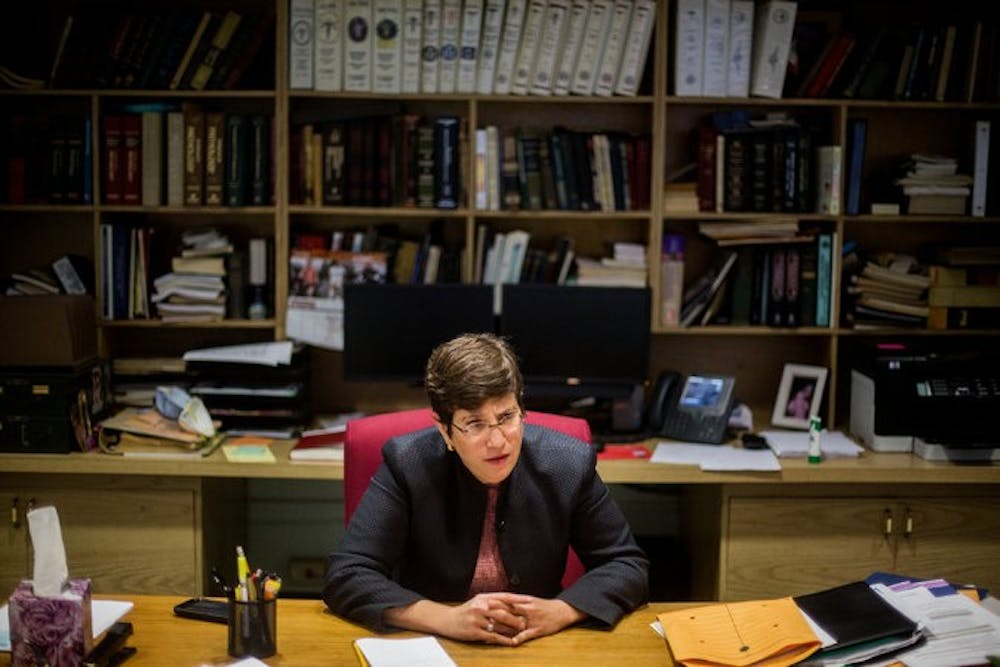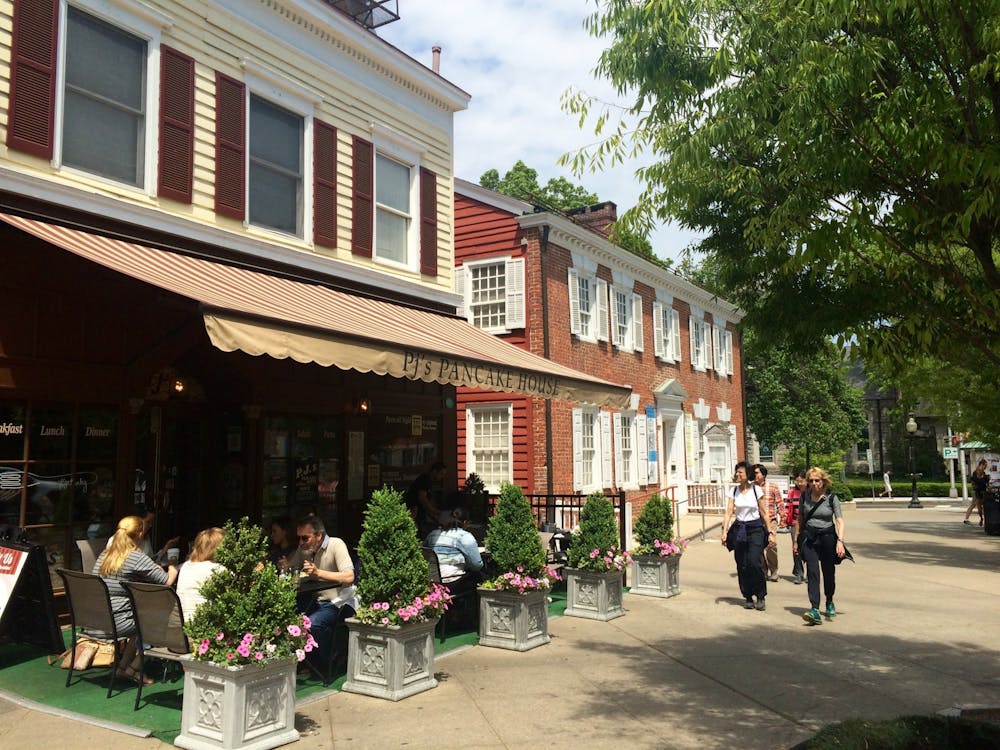MICROSCOPIC ESCAPADES
When Barbara Sampson ’88 was growing up, both of her parents were actively practicing medicine. It was never a question of if she would become a doctor; it was a question of when.
One day, when she was very young, her father asked her, “How about pathology?” Sampson was immediately intrigued by this question. The thought of becoming a doctor’s doctor — the one who gave other physicians the answer to why a patient had died — was fascinating to her. According to Sampson, “Everything I learned about pathology from then on only supported my decision.”
Sampson’s college search was marked with the same sense of steadfastness. She chose Princeton once she recognized that the required independent work would truly force her to look into research. Soon enough, the molecular biology building, which now houses the chemical and biological engineers, became her second home.
As Sampson puts it, “molecular biology was blossoming” when she entered the university in 1984. “It was obvious from day one that that would be my major,” she said. Molecular biology would continue to flourish for the next four years and beyond.
Sampson knew she wanted to focus on research from the outset. “One day over the summer between my freshman and sophomore year, I remember walking into the first floor of the molecular biology building,” she said. “I spoke with a very nice secretary and told her of my aspirations. She, however, wasn’t sure that the lab I had in mind, which was cancer-related, would have any opportunities for a freshman.”
Fortuitously, an E. coli laboratory just down the hall was looking for a fresh-eyed undergraduate researcher. Sampson now knows that an entire world of research was opened for her when she entered that laboratory.
When Sampson secured her spot in the E. coli laboratory, she became one of the first undergraduate researchers in the Department of Molecular Biology. A young research faculty member named Spencer Benson quickly recognized her potential and took her under his wing, acting as her direct adviser.

Fittingly, Sampson spent much of her time in the lab. The countless hours of research bore fruit when she, along with the other researchers, discovered a mutation, which is now called lptD. It quite clearly changed the course of the laboratory’s work. Through lptD, Sampson had discovered a new way to increase membrane permeability in bacteria like E. coli. Pharmaceutical companies use this mutation to screen for new and improved medications.
However, Sampson did not know its usefulness at the time. When she learned of it many years later, she responded by laughing it off. You will never hear Sampson boasting in any way.
A NEW PATH
After earning a doctorate in molecular biology at Rockefeller University and a medical degree at Cornell University Medical College, she turned to the subject that had captivated her attention many years ago: forensic pathology.

The research experience that Sampson had accrued at the E. coli laboratory proved very useful. After all, as Sampson puts it, “The approach one uses in the laboratory is the same approach one uses down in the autopsy room.”
“Everything you know from every part of your life feeds into your death investigations. The broader your experience is, the better equipped you are,” Sampson said.
Upon entering the field, Sampson met Dr. Charles Hirsch, another man who quickly saw Sampson’s potential and decided to become a mentor to her. Hirsch, New York City’s Chief Medical Examiner at the time, would become quite famous a few years later for overseeing the identification of 9/11 victims. According to Sampson, Hirsch was the “father of modern forensic science.”
Sampson worked under Hirsch for 15 years. She acted as his second in command, as first deputy chief medical examiner, for seven of those years until she became acting chief medical examiner following Hirsch’s retirement. Later that year, in Dec. 2014, Mayor Bill de Blasio appointed her as New York City’s first female chief medical examiner.
The official website of the Office of Chief Medical Examiner explains that Sampson, as chief medical examiner, “oversees investigations into deaths in New York City, and the operation of the largest DNA laboratory in the nation.” The DNA laboratory is quite close to the official OCME building, located on the corner of First and 30th Streets.
A Flag of Honor in the lobby of the OCME building adorns one of the walls. “This flag is created from the names of those who perished in the terrorist attacks of September 11, 2001,” it reads. After all, another important function of the chief medical examiner is to oversee mass fatality responses.
“When 9/11 happened, I was one of the city’s medical examiners, two or three years out of my training,” explained Sampson. “The medical examiner’s office played an important role in analyzing the human specimens recovered from Ground Zero in the months after 9/11. This office was functioning day and night, 24/7.”
According to Sampson, “Of the approximately 2,000 people that were killed on that day, only 60 percent have been identified by scientific means. That means that 40 percent of families don’t have positive scientific identification. Dr. Hirsch made the commitment that we will do whatever it takes, for as long as it takes, to make as many identifications as possible — I have reiterated this commitment,” she said.
Thus, Sampson meets with the families of the victims around 9/11 each year to explain the progress made. Although the process is slow and painstaking, the persistence of Sampson and her medical examiners shines through.
Sampson has also decided to focus on the large amount of unidentified decedents in New York City. She has made finding the family members of these individuals an important part of the OCME. Missing Persons Day was created in this vein.
WHERE THE DEAD SERVE THE LIVING
Another wall in the lobby of OCME’s building is decorated with a sprawling Latin inscription. Translated to English, it reads: “Let conversation flee. Let laughter flee. This is the place where death delights to help the living.” This inscription perfectly encapsulates Sampson’s profession.
“Investigations done by medical examiners have the power to potentially identify a perpetrator or exonerate someone falsely accused of a crime,” she said.
According to Sampson, these investigations prove quite useful even when they are not of homicides. In fact, of the roughly 5,500 autopsies done in New York City every year, over half of them are natural deaths. These investigations can help family members tremendously.
For example, the medical examiner’s office is able to “definitively tell a mother who lost her baby that ‘there was nothing you could have done.’”
Sampson says that they can also help the parents of children who die of certain diseases by informing them about how to proceed with subsequent pregnancies and family planning. Additionally, if a medical examiner finds a genetic disease in one family member, they can refer the entire family for clinical testing, free of charge.
From the outset, Sampson’s work was cut out for her. Criticism of quality assurance was common in the city’s papers. For an office that had grown substantially in the past 15 years, Sampson commented that a drop in quality assurance was not surprising. “When something grows organically like our office did, the processes that are in place don’t necessarily grow along with it. When I became chief medical examiner, I had the opportunity to reexamine these processes. I had the opportunity to optimize what we do here,” Sampson said.
Fortunately for Sampson, the office of New York City’s chief medical examiner is well-funded. It has a well-built infrastructure and it is entirely independent of sources which may corrupt it. According to Sampson, “Many of the problems that other jurisdictions face are avoided here. For example, there is a lack of medical examiners in many jurisdictions; in fact, some states have no medical examiners at all.” However, Sampson recognizes that there is always more work to be done. “We have to stay on the cutting edge of science,” she said, “we have to keep pushing the envelope.”
By city charter, the OCME investigates every death that is sudden, violent, or unexpected. “We handle every decedent equally. If you require molecular genetic testing, you’re going to get it. If you require advanced toxicology screening, you’re going to get it,” Sampson explained. “Anyone could end up here,” she added. “They could have lived on Park Avenue or a park bench. They all look the same when they get downstairs.”
There are no funeral vibes to be felt when walking around the chief medical examiner’s office on the corner of First and 30th Streets. The medical examiners shuffling through the lobby are lively, social, and, above all else, compassionate.
It is clear that Dr. Barbara Sampson and her medical examiners are not overly concerned with death. They are, however, overwhelmingly concerned with life.








